Electrolytic SMD capacitors offer compact size and surface-mount convenience ideal for high-density PCBs, while electrolytic radial capacitors provide higher capacitance values with robust durability suited for through-hole mounting. Explore the differences and select the perfect capacitor to optimize your electronic designs by reading the full article.
Comparison Table
| Feature | Electrolytic SMD Capacitor | Electrolytic Radial Capacitor |
|---|---|---|
| Mounting Type | Surface-Mount Device (SMD) | Through-Hole Radial Leads |
| Size | Compact, low profile | Larger, bulkier |
| Applications | High-density PCBs, compact electronic devices | Power supplies, general-purpose circuits |
| Voltage Range | Typically up to 50V | Up to 450V or higher |
| Capacitance Range | Typically 0.1uF to several thousand uF | Wide range, often higher capacitance values |
| Reliability | Good, with lower ESR | Stable, robust under stress |
| ESR (Equivalent Series Resistance) | Lower ESR, better for high-frequency | Higher ESR compared to SMD |
| Assembly | Reflow soldering compatible | Wave soldering or manual soldering |
| Cost | Generally more expensive per unit | Cost-effective for bulk applications |
Introduction to Electrolytic Capacitors
Electrolytic capacitors offer high capacitance values in compact sizes, essential for filtering and energy storage in electronic circuits. Surface mount device (SMD) electrolytic capacitors provide space-saving mounting on printed circuit boards, while electrolytic radial capacitors feature axial leads suited for through-hole assembly and higher voltage ratings. Understanding these types helps you choose the right capacitor for reliability and performance in your electronic designs.
Overview of SMD and Radial Electrolytic Types
Surface-mount device (SMD) electrolytic capacitors are designed for compact PCB layouts, featuring a low-profile rectangular shape that supports automated assembly and high-density mounting. Radial electrolytic capacitors have two leads extending from the bottom, offering larger capacitance values and higher voltage ratings, suitable for through-hole mounting and applications requiring robust mechanical stability. The choice between SMD and radial electrolytic capacitors depends on space constraints, electrical requirements, and manufacturing processes in electronic circuit design.
Construction Differences: SMD vs Radial
Electrolytic SMD capacitors feature a compact, surface-mount design with flat terminals on either end, enabling automated PCB assembly and reduced parasitic inductance. In contrast, electrolytic radial capacitors have axial leads extending from one end, housed in a cylindrical casing suitable for through-hole mounting and providing higher capacitance values in larger footprints. The structural variation affects thermal dissipation, mounting technique, and electrical performance, making SMD capacitors optimal for high-density circuits and radial types preferred for higher voltage or capacitance requirements.
Physical Size and Mounting Considerations
Electrolytic SMD capacitors are significantly smaller and designed for surface-mount technology, enabling automated placement and minimizing board space, which suits compact and high-density PCB layouts. Electrolytic radial capacitors have larger physical sizes with axial leads for through-hole mounting, requiring more space and manual or wave soldering processes. Your choice depends on available PCB real estate and assembly methods, with SMD capacitors offering superior size efficiency and radial capacitors providing robust mechanical stability.
Performance Characteristics Comparison
Electrolytic SMD capacitors offer lower equivalent series resistance (ESR) and improved high-frequency performance compared to electrolytic radial capacitors, making them ideal for compact, high-speed circuits. Radial electrolytic capacitors provide higher capacitance values and greater voltage ratings, suited for applications requiring bulk energy storage and filtering in power supplies. Your choice depends on balancing size constraints and electrical performance requirements, with SMD capacitors optimized for surface-mount designs and radial types for through-hole mountings.
Reliability and Lifespan
Electrolytic SMD capacitors generally offer improved reliability and a longer lifespan due to their compact structure and better heat dissipation compared to electrolytic radial capacitors, which often experience higher mechanical stress from leads. The solid construction of SMD capacitors reduces the risk of electrolyte leakage and enhances performance stability under thermal cycling and vibration. Radial capacitors, while cost-effective, typically have shorter operational lifespans and greater susceptibility to physical damage in demanding environments.
Common Applications for Each Type
Electrolytic SMD capacitors are widely used in compact electronic devices like smartphones, laptops, and wearable technology due to their small size and surface-mount capability, ideal for high-frequency applications and power supply filtering on densely populated PCBs. Electrolytic radial capacitors are commonly found in power supply circuits, audio equipment, and industrial machines where higher capacitance values and robust mechanical stability are required for energy storage and ripple filtering. Both types serve critical roles in smoothing voltage fluctuations and stabilizing power delivery, with SMD capacitors favored for miniaturization and radial capacitors for high capacitance and durability.
Soldering and Assembly Differences
Electrolytic SMD capacitors are designed for surface-mount technology, enabling automated soldering with reflow ovens, which offers precise placement and minimal lead stress during assembly. In contrast, electrolytic radial capacitors feature axial leads requiring through-hole soldering, typically involving wave soldering or manual soldering processes that can increase assembly time and labor costs. Your choice impacts manufacturing efficiency and reliability, with SMD capacitors favoring compact, high-speed production environments compared to the more robust but bulkier radial types.
Cost and Availability Factors
Electrolytic SMD capacitors generally offer lower costs and better availability due to their widespread use in compact electronic devices and automated assembly processes. Radial electrolytic capacitors, while often more affordable in bulk for through-hole applications, can face limited availability in smaller sizes and advanced electric vehicle or industrial markets. Your choice depends on the volume, application design, and procurement ease, with SMD types excelling in high-demand electronics production environments.
Choosing the Right Electrolytic Capacitor for Your Design
Electrolytic SMD capacitors offer compact size and automated assembly advantages, making them ideal for densely populated PCBs and modern surface-mount technology designs. Electrolytic radial capacitors, with their larger physical size and higher capacitance options, suit applications requiring higher voltage ratings and more robust power filtering. Choosing the right electrolytic capacitor depends on your circuit's space constraints, voltage and capacitance requirements, and assembly process compatibility.
Electrolytic SMD vs electrolytic radial capacitor Infographic

 solderic.com
solderic.com